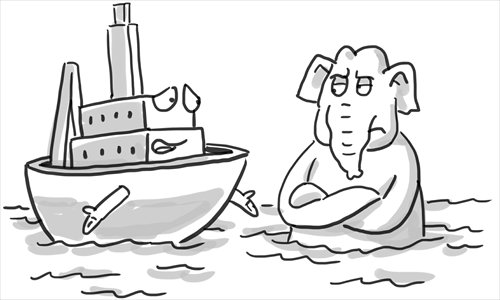India’s political goals hinder cooperation with China on ‘Belt, Road’

Illustration: Liu Rui/GT
The Indian Ocean is a major region that the 21st century maritime Silk Road (MSR) initiative passes through. The 21st century MSR is consistent with China's maritime power strategy. The strategy is about how to explore, use, protect and manage the ocean peacefully. It involves maritime security, especially the protection of China's islands in East and South China seas and China's energy and trade sea lanes. But in general, it is not a military strategy.
Western scholars forged and hyped China's "string of pearls strategy" in the Indian Ocean, and some Indians believe that the 21st century MSR is just an alternative wording that sounds more pleasant and is used to replace the string of pearls strategy.
The so-called string of pearls strategy is a military and geostrategic design. But Chinese leaders define the "Belt and Road" initiative as the top-level design of China's opening-up and economic diplomacy in the new era, and Chinese solutions and suggestions toward world peace and development. In essence, the "Belt and Road" initiative is a geoeconomic cooperative design, and not a geopolitical or geostrategic one.
When China initiated the 21st century MSR in 2013, then Indian prime minister Manmohan Singh and his national security advisor Shivshankar Menon expressed support and interest. But current Prime Minister Narendra Modi changed India's attitude toward the MSR after he came into power.
Indian strategists and the government believe there is some geostrategic design behind the "Belt and Road" initiative. Now, India has adopted opposing, delaying and hedging measures toward different parts of the initiative. Some strategists regard the Bangladesh-China-India-Myanmar (BCIM) economic corridor and the China-Pakistan economic corridor (CPEC) as parts of the 21st century MSR, because both of these corridors lead to the Indian Ocean.
India opposes CPEC and delays the process of BCIM, and puts forward its own interconnectivity project. It also advances Project Mausam, Cotton Route, Spice Route, or Sagar Mala projects, and upgraded "Look East" policy to "Act East" policy, to hedge the 21st century MSR.
India's reaction toward the "Belt and Road" initiative is a part of its Indo-Pacific strategy. It has three features. First of all, India takes precedence of geopolitics over geoeconomic cooperation. Second, Indian hedging strategy toward the "Belt and Road" has very strong military and strategic implications. The "Belt and Road" initiative is an economic cooperation, and China will invest a large amount of capital along the route that India cannot match. Modi's visit to three Indian Ocean countries in March 2015 shows that India is determined to adopt an asymmetrical strategy to secure a dominant position in the Indian Ocean through bolstering military and security cooperation with these island nations.
Last, India enforced its military and strategic coordination with the US, Japan and some Southeast Asian countries which have islands disputes with China in the South China Sea.
So in the Indo-Pacific region, there is competition between geoeconomic cooperation and geopolitical cooperation. India, the US and Japan want to hedge economic and trade cooperation initiated by China with their military and security cooperation. This situation does not benefit the advancement of the "Belt and Road" initiative.
How to deal with this situation? First, China should make clear its purposes in the Indian Ocean, i.e. the security of sea lanes of energy and trade, the security of overseas investment and the security of overseas Chinese, to build strategic trust with Indian Ocean countries, especially India.
Second, China should step up efforts to improve maritime economic cooperation, maritime interconnection, civil cooperation, disaster relief cooperation, legal cooperation and other maritime security activities, providing more international public goods collectively with other countries, to ensure the security of sea lanes and freedom of navigation in the Indian Ocean.
Last, in the long run it is necessary to build a stable regional security architecture. China should continue to advocate new security concepts and make efforts to build an inclusive and democratic regional security architecture. China should improve connections and cooperation with the Indian Ocean Rim Association and other regional cooperation organizations in the Indian Ocean. At the same time, China should improve maritime cooperation with India.
The author is a senior fellow of Shanghai Institutes for International Studies and a visiting fellow of the Chongyang Institute for Financial Studies, Renmin University of China. opinion@globaltimes.com.cn. Follow us on Twitter @GTopinion